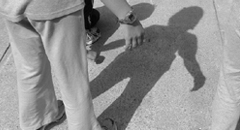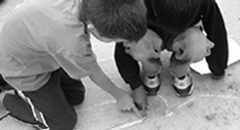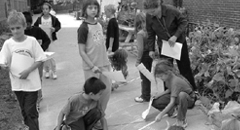
|

|

|
Purpose
- To offer an engaging way to launch a conversation about how learning groups form, function, and demonstrate understanding in your setting.
- To involve students in research questions about learning in groups.
Preparation
- Choose a visual essay in the MLV book that you think will be especially engaging for your students. Prepare the visual essay for presentation (e.g., xerox from the book, use overheads or powerpoint, or, if your group is small enough to see the images, just read directly from the book). The City of Reggio (Boys and Girls) and Ring-Around-the-Rosy have worked well in the past.
- Practice reading through the essay before presenting it to your students and edit the adult narrative as appropriate for your age group. If possible, meet with a colleague to discuss why you chose the essay and the things about group learning you would like to discuss or make visible for your students.
- Think through the kind of conversation you hope to have with your students and any questions you want to ask. We provide suggestions for questions below. Jot down your hypotheses about how you think students will respond to the essay. What would you like to learn about your students' feelings and ideas about learning in groups?
- Think about how you would like to organize the presentation and discussion. Would you prefer a whole-group conversation about the essay or small-group discussions. Think about what forms of documentation will capture the things you most want to learn and choose at least two ways to document the conversation such as a tape recorder and a few photographs or notes.
Presentation and Discussion (time frame: 45-60 minutes)
- Begin with some discussion about learning in groups, perhaps by first asking students about their own experiences. You might ask:
- What are some things that you learn best by yourself?
- What are some things that you think you learn best in a group?
- How did this group learn together?
- Can you think of a group you have been a part of that worked well or helped you learn?
- What do you think are some of the signs that a group is working well together?
- When you learn in a group, do you all learn the same thing?
- How do you decide on things in a group?
- Which do you like better—working/learning alone or in a group? Why?
- What can be hard about learning in a group? Learning alone?
- Pretend you're the teacher of this class and you want to put kids into groups to learn about _____________. How would you do it? (What size groups? With friends or not? Gender? Mix of skills or interests? With or without adults?)
- What things would you look for that would let you know people in a group were learning?
- What advice would you give me if I wanted to document how you learn and think? Individually? In a group?
- Do you have any questions for me?
Reflection
- As soon as you have a free moment after the discussion, quickly review the documentation you gathered and add any notes that will help you remember key moments or highlights that shed light on your questions about learning in groups.
- Get your documentation into a format that you can share with one or more colleagues.
- Share your documentation and ask your colleague(s) to share his or her own interpretations. Choose one or more moments, observations, or interpretations to share back with your students.
© 2004 Making Learning Visible Project at the Harvard Graduate School of Education
[Home] [Site Map]
